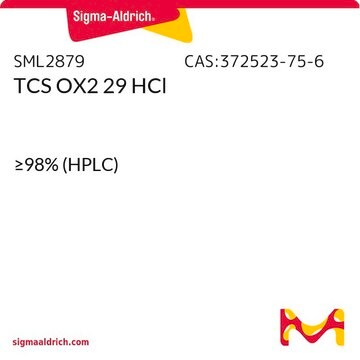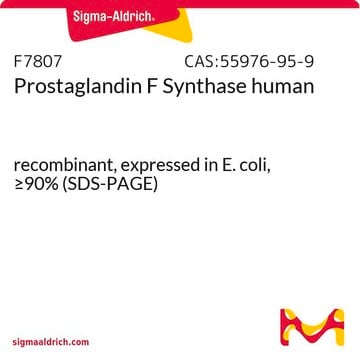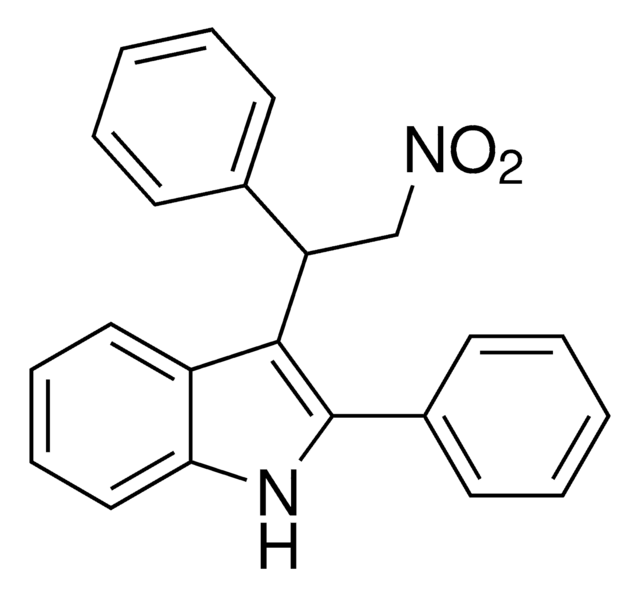SML2140
TCS 401
≥98% (HPLC)
Synonym(s):
2-[(Carboxycarbonyl)amino]-4,5,6,7-tetrahydrothieno[2,3-c]pyridine-3-carboxylic acid hydrochloride, TCS-401, TCS401
Sign Into View Organizational & Contract Pricing
All Photos(1)
About This Item
Empirical Formula (Hill Notation):
C10H10N2O5S · xHCl
CAS Number:
Molecular Weight:
270.26 (free base basis)
UNSPSC Code:
12352200
NACRES:
NA.77
Recommended Products
Assay
≥98% (HPLC)
form
powder
color
white to beige
solubility
0.1 M NaOH: 2 mg/mL, clear (warmed)
storage temp.
2-8°C
Biochem/physiol Actions
TCS 401 is a selective inhibitor of protein-tyrosine phosphatase 1B (PTP1B), which plays a key role in the negative regulation of the insulin signaling pathway, contributing to insulin resistance. It exhibited Ki values of 290 nM for PTP1B, with greater than 100-fold or more selectivity compared to other phosphatases. Inhibition of PTP1B by TCS 401 has been shown to sensitize the insulin signaling pathway and increase dopamine release in response to insulin. TCS-401 has also been shown to promote endothelial cell motility and to induce differentiation of retinal pigment epithelial cells toward improved contractility and motility.
Storage Class Code
11 - Combustible Solids
WGK
WGK 3
Flash Point(F)
Not applicable
Flash Point(C)
Not applicable
Certificates of Analysis (COA)
Search for Certificates of Analysis (COA) by entering the products Lot/Batch Number. Lot and Batch Numbers can be found on a product’s label following the words ‘Lot’ or ‘Batch’.
Already Own This Product?
Find documentation for the products that you have recently purchased in the Document Library.
Steve C Fordahl et al.
ACS chemical neuroscience, 8(2), 290-299 (2016-12-15)
Systemically released insulin crosses the blood-brain barrier and binds to insulin receptors on several neural cell types, including dopaminergic neurons. Insulin has been shown to decrease dopamine neuron firing in the ventral tegmental area (VTA), but potentiate release and reuptake
L F Iversen et al.
The Journal of biological chemistry, 275(14), 10300-10307 (2000-04-01)
Several protein-tyrosine phosphatases (PTPs) have been proposed to act as negative regulators of insulin signaling. Recent studies have shown increased insulin sensitivity and resistance to obesity in PTP1B knockout mice, thus pointing to this enzyme as a potential drug target
Samuel Legeay et al.
Biomedicine & pharmacotherapy = Biomedecine & pharmacotherapie, 127, 110200-110200 (2020-05-18)
Diabetes notably increases the risk for endothelial dysfunction, a main precursor for microvascular complications. While endoplasmic reticulum stress (ERS) and protein tyrosine phosphatase 1B (PTP1B) have been associated with endothelial dysfunction in resistance vessels, whether these mechanisms also contribute to
Zhao-dong Du et al.
Molecular vision, 21, 523-531 (2015-05-23)
To determine whether protein tyrosine phosphatase 1B (PTP1B) is expressed in rat retinal pigment epithelium (RPE) cells, to evaluate whether inhibition of PTP1B contributes to initiation of RPE cells into an active state, and to investigate the signaling pathways involved
Our team of scientists has experience in all areas of research including Life Science, Material Science, Chemical Synthesis, Chromatography, Analytical and many others.
Contact Technical Service







